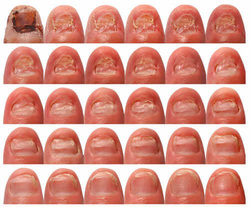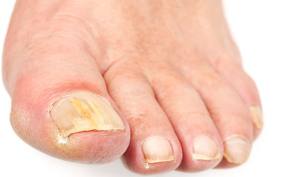
Nail discoloration in the nail plate signifies a variety of nail infections. Oftentimes, discolored toenails are telling signs of the severity of an infection. A white or slight yellowish discoloration is the first visible sign of fungal infection. Then, it proceeds to turn green, then brown, then black until the dark color spreads all over the nail plate. The cause could be a common fungus that is found in warm and damp places.
This discoloration may lead to nail plate thickening and eventual separation while the fungus creates rough edges on the side of the nails. Nutritional supplementation with Vitamin E has been proven effective in controlling nail changes. Early treatment can also prevent complications. Below are the different kinds of nail discolorations:
· White toenails
White toenail fungus is also known as white superficial Onychomycosis. An opaque white or off-white color may be seen on the nail plates. This condition of nail discoloration indicates an early stage of nail fungal infection. As the fungus gradually progresses, the nail displays uneven edges and becomes crumbly. Nails may also appear lightened to a whitish-yellow color if there has been separation of the nail from the nail bed.
Improving general health and adopting preventive measure may improve the chances of a cure. Toenail fungus diet aims to eliminate dietary sources of sugar and protein to inhibit fungal growth. Keeping the feet or toenails dry may prevent the nail from attracting fungi. Mild treatment is advisable for this stage of discolored toenails.
· Yellow toenails
Yellow nails signal that a mild fungal infection is present in the nails. There are various types of fungus thrive that can cause your toenails to turn yellow. Sweat in the shoes can be the cause of this problem too since most of this organisms stay in a hot and moist environment.
An immediate mild treatment or remedy is necessary, not letting the nail fungal infection to progress which may result to an even darker discoloration which signifies a worse nail infection.
· Brown toenails
Brown toenails provide clues to the presence of a nail fungus disease. Fungi develop and commonly grow on toes because they are usually covered in socks and shoes, creating an anaerobic environment. Once the fungus builds up, it will discolor your toenails with a dull brown color.
There are a few causes of brown toenails. Wearing tight shoes may cause discolored toenails. The infected person may also experience a slight pain when walking on the contaminated toe.
· Dark toenails
Conditions such as heart diseases, liver or kidney problems, and nutritional deficiencies can show up in our nails. There are some possibilities that can cause dark coloring of the fingernails. Not having enough vitamin B-12 can cause nails to turn dark, thin and possibly spoon shaped.
Dark spots or streaks rather than full discoloration of the nails may be caused by a certain kind of nail fungus. This may also lead to a much darker color as the contaminant continues to grow in the nail bed which is beneath the nail plate.
· Black toenails
Black nail is an indication of having a serious nail fungal infection. This may lead to intense pain or discomfort that the sufferer might find walking or wearing shoes difficult. The fungus tends to thrive in such warm and humid places where most people walk barefooted.
The fungus destroys the keratin of the nails, making them look unattractive. The fungus eventually infects the nails as well as the cuticle and may then produce a black color. There may be pain associated with redness, swelling and foul odor too. This condition is considered severe and needs immediate treatment to ensure that it cannot spread to the entire nail or nail root and ultimately discharge the infected nail from its nail bed.
Knowing the stages for each corresponding discolored toenail is vital in treating your fungal infection. Watch out for the first signs of nail discoloration which is just a white blotch on the nail.
A proper treatment of this unsightly toenail may recover the nail’s healthy look again in no time. There are a lot of toenail fungus treatments out there like taking certain oral medications but are said to be harmful on the liver or for those who have diabetes. So most infected people turn into home remedies that can give wonderful results. It involves using plants or natural substances like vinegar which extremely work well and brings no dangerous side effects.
There are some popular topical medications that are effective in treating fungal infections. Just like home remedies, they also contain natural ingredients which are best in clearing any nail fungus on the nail plate and penetrate down the nail bed for excellent results. These medications work best for discolored toenails or nasty fungal infections if the treatment instructions are carefully followed.
To know what can be the cause of your nail discoloration and to be sure you are safe from nail fungus, you can click this link for more information.
This discoloration may lead to nail plate thickening and eventual separation while the fungus creates rough edges on the side of the nails. Nutritional supplementation with Vitamin E has been proven effective in controlling nail changes. Early treatment can also prevent complications. Below are the different kinds of nail discolorations:
· White toenails
White toenail fungus is also known as white superficial Onychomycosis. An opaque white or off-white color may be seen on the nail plates. This condition of nail discoloration indicates an early stage of nail fungal infection. As the fungus gradually progresses, the nail displays uneven edges and becomes crumbly. Nails may also appear lightened to a whitish-yellow color if there has been separation of the nail from the nail bed.
Improving general health and adopting preventive measure may improve the chances of a cure. Toenail fungus diet aims to eliminate dietary sources of sugar and protein to inhibit fungal growth. Keeping the feet or toenails dry may prevent the nail from attracting fungi. Mild treatment is advisable for this stage of discolored toenails.
· Yellow toenails
Yellow nails signal that a mild fungal infection is present in the nails. There are various types of fungus thrive that can cause your toenails to turn yellow. Sweat in the shoes can be the cause of this problem too since most of this organisms stay in a hot and moist environment.
An immediate mild treatment or remedy is necessary, not letting the nail fungal infection to progress which may result to an even darker discoloration which signifies a worse nail infection.
· Brown toenails
Brown toenails provide clues to the presence of a nail fungus disease. Fungi develop and commonly grow on toes because they are usually covered in socks and shoes, creating an anaerobic environment. Once the fungus builds up, it will discolor your toenails with a dull brown color.
There are a few causes of brown toenails. Wearing tight shoes may cause discolored toenails. The infected person may also experience a slight pain when walking on the contaminated toe.
· Dark toenails
Conditions such as heart diseases, liver or kidney problems, and nutritional deficiencies can show up in our nails. There are some possibilities that can cause dark coloring of the fingernails. Not having enough vitamin B-12 can cause nails to turn dark, thin and possibly spoon shaped.
Dark spots or streaks rather than full discoloration of the nails may be caused by a certain kind of nail fungus. This may also lead to a much darker color as the contaminant continues to grow in the nail bed which is beneath the nail plate.
· Black toenails
Black nail is an indication of having a serious nail fungal infection. This may lead to intense pain or discomfort that the sufferer might find walking or wearing shoes difficult. The fungus tends to thrive in such warm and humid places where most people walk barefooted.
The fungus destroys the keratin of the nails, making them look unattractive. The fungus eventually infects the nails as well as the cuticle and may then produce a black color. There may be pain associated with redness, swelling and foul odor too. This condition is considered severe and needs immediate treatment to ensure that it cannot spread to the entire nail or nail root and ultimately discharge the infected nail from its nail bed.
Knowing the stages for each corresponding discolored toenail is vital in treating your fungal infection. Watch out for the first signs of nail discoloration which is just a white blotch on the nail.
A proper treatment of this unsightly toenail may recover the nail’s healthy look again in no time. There are a lot of toenail fungus treatments out there like taking certain oral medications but are said to be harmful on the liver or for those who have diabetes. So most infected people turn into home remedies that can give wonderful results. It involves using plants or natural substances like vinegar which extremely work well and brings no dangerous side effects.
There are some popular topical medications that are effective in treating fungal infections. Just like home remedies, they also contain natural ingredients which are best in clearing any nail fungus on the nail plate and penetrate down the nail bed for excellent results. These medications work best for discolored toenails or nasty fungal infections if the treatment instructions are carefully followed.
To know what can be the cause of your nail discoloration and to be sure you are safe from nail fungus, you can click this link for more information.

 RSS Feed
RSS Feed